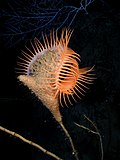Sea anemone
Sea anemones are Cnidarian animals that live in the sea. They are polyps, one of the basic forms of the phylum. They are predatory animals, which paralyse their prey with stinging nematocysts. These fire a harpoon-like structure which delivers a dose of neurotoxins. To eat the fish, or crustacean, they move the prey into their stomach, where they are slowly digested.[1]
| Sea anemones | |
|---|---|

| |
| A selection of sea anemones, painted by Giacomo Merculiano, 1893 | |
| Scientific classification | |
| Unrecognized taxon (fix): | Hexacorallia |
| Order: | Actiniaria |
| Suborders | |
| Diversity | |
| 46 families | |

Anemones are sessile. This means they like to stay in one area. They can move very slowly along the bottom. Some types can swim to a new location by using flexing movements. Many species live in rockpools between high tide and low tide, and on rocky shores generally. Anemones can be found in deep oceans as well, and a few are pelagic.[2]
An anemone has an oral disk on the top of its body. The sea anemone’s mouth and gut are in the middle of the oral disk. The tentacles surround the oral disk. The pedal disc is on the bottom of the sea anemone.
Some sea anemones live in symbiosis with other animals. clownfish, Incognito goby, and arrow crabs may shelter among the tentacles of the anemone. Hermit crabs often have sea anemones on the shell they live in. Some anemones have a symbiosis with a type of algae which lives inside them. This is the same thing many corals do. The dinoflagellate algae use sunlight to make food, and the anemone uses some of the food.
The first detailed investigation of sea anemones was a survey of those found on or near the beaches of the British Isles by the naturalist Philip Henry Gosse.[3]
Sea Anemone Media
Sea anemone anatomy.1. Tentacles 2. Mouth 3. Retracting muscles 4. Gonads 5. acontial filaments 6. Pedal disk 7. Ostium 8. Coelenteron 9. Sphincter muscle 10. Mesentery 11. Column 12. Pharynx
A tomato clownfish in a sea anemone
Actinodendron arboreum, the hell's-fire anemone
Brooding anemone (Epiactis prolifera) with developing young
Assortment of sea anemones from Ernst Haeckel's Kunstformen der Natur
Tentacles of Aulactinia veratra catch passing prey and thrust it into the mouth in the middle of the oral disc.
The Venus flytrap sea anemone is a suspension feeder and orients itself to face the current.
Ocellaris clownfish among the tentacles of a sebae anemone
References
- ↑ Ruppert, Edward E; Fox, Richard S; Barnes, Robert D. 2004. Invertebrate Zoology (7th ed). Cengage Learning. pp. 130–132. ISBN 978-81-315-0104-7
- ↑ Goffredo, Stefano; & Dubinsky, Zvy eds. 2016. The Cnidaria, past, present and future: the world of Medusa and her sisters. Springer International Publishing. p. 240. ISBN 978-3-319-31305-4
- ↑ Gosse P.H. 1860. Actinologica Britannica. A history of the British sea-anemones and corals, with coloured figures of the species and principal varieties. London, Van Voorst.









